WEBINARS

AM-SMART is a bi-monthly scientific webinar series that lasts approximately one hour. Each session features two speakers from different institutes who present their latest achievements and share groundbreaking research, fostering knowledge exchange and innovation. Each presentation lasts about 30 minutes, including a Q&A session for each talk.
2023
- Webinar 1, December 2023
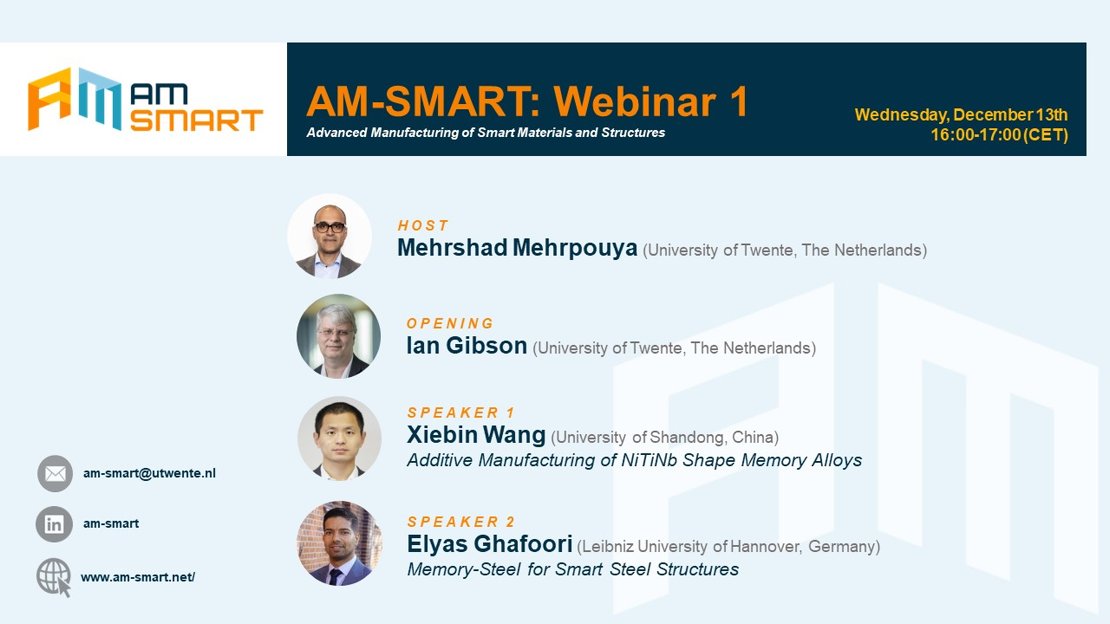
Host: Mehrshad Mehrpouya (University of Twente, The Netherlands)
Speaker 1: Xiebin Wang (University of Shandong, China)
Title: Additive Manufacturing of NiTiNb Shape Memory Alloys
Adding ternary alloying elements is an efficient strategy to modulate the phase transformation behavior and functional properties, thus expanding the practical applications of NiTi-based shape memory alloys (SMAs). However, it is quite challenging to fabricate ternary SMAs via conventional metallurgical techniques, mainly due to the large difference in melting points, as well as the high chemical reactivity of the elements. Laser powder bed fusion (L-PBF), as an additive manufacturing technique, is attracting increasing interest due to its ability to fabricate geometrically complex structures. Also, L-PBF is a potential approach for in-situ alloying, since the melt-pool flow behavior is very dynamic due to the Marangoni convection and recoil pressure, which lead to intensive mixing of the melts. Together with the ability to fabricate complex structures and the feasibility to tune the phase transformation behavior, L-PBF provides great potential for producing NiTi-based shape memory alloy structures with novel functionalities.
- R. Xi, H. Jiang, S. Kustov, Z. Zhang, G. Zhao, K. Vanmeensel, J. Van Humbeeck, X. Wang. Influence of Nb addition and process parameters on the microstructure and phase transformation behavior of NiTiNb ternary shape memory alloys fabricated by laser powder bed fusion. Scripta Materialia, 2023, 222: 114996. https://doi.org/10.1016/j.scriptamat.2022.114996
- X. Wang, J. Yu, J. Liu, L. Chen, Q. Yang, H. Wei, J. Sun, Z. Wang, Z. Zhang, G. Zhao, J. Van Humbeeck. Effect of process parameters on the phase transformation behavior and tensile properties of NiTi shape memory alloys fabricated by selective laser melting. Additive Manufacturing, 2020, 36: 101545. https://doi.org/10.1016/j.addma.2020.101545
Speaker 2: Elyas Ghafoori (Leibniz University of Hannover, Germany)
Title: Memory-Steel for Smart Steel Structures
This presentation explores the development and application of iron-based shape memory alloy (Fe-SMA), the so-called memory-steel, for steel structures. First, the studies on the material properties of Fe-SMA in terms of shape memory effect and superelasticity are discussed. Next, the use of Fe-SMA in a prestressed strengthening of steel structures is explained, including the applications in strengthening steel girders, connections, and fatigue crack repairs. Various strengthening solutions such as using mechanically anchored or adhesively-bonded Fe-SMA, as well as the studies on the behavior of the Fe-SMA-to-steel bonded joints, are discussed. The use and application of Fe-SMA for strengthening a 113-years steel bridge has been explained. In addition, studies on the innovative application of the Fe-SMA as pipe couplers are presented. In the end, innovative ongoing research on the additive manufacturing of architected Fe-SMA (4D-printing) is discussed.
- Wang, S., Mohri, M., Li, L., Izadi, M., Jafarabadi, A., Pichler, N., & Ghafoori, E. (2023). Memory‐Steel for Smart Steel Structures: A Review on Recent Developments and Applications. ce/papers, 6(3-4), 949-958.
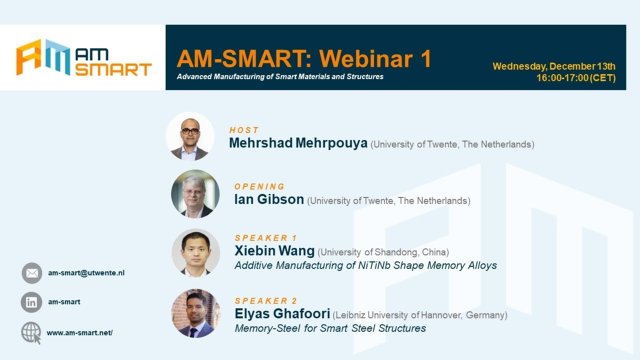
2024
- Webinar 2, February 2024

Host: Mohammad Elahinia (The University of Toledo, USA)
Speaker 1: Othmane Benafan (NASA Glenn Research Center, USA)
Title: Microstructural stability of shape memory alloys by additive manufacturing-dispersion strengthening
Shape memory alloys (SMA) are commonly strengthened by solid solution or precipitation strengthening, where the latter is only effective in certain chemistry ranges or at some applicable temperatures. (e.g., Ni-rich NiTi alloy, usage temperatures below precipitate solubility). This study is targeted towards augmenting the need for SMA strengthening via additive manufacturing-dispersion strengthening (AM-DS). This is accomplished by incorporating a fine dispersion of submicron particles such as oxides into a SMA powder followed by additive manufacturing using Laser Powder Bed Fusion (LPBF). This dispersion methods will aid in stabilizing alloys in achieving better dimensional and thermal stability, more effective training procedures, and higher strength. Details of this method, production challenges and preliminary results are presented.
- Othmane Benafan, Glen S. Bigelow, and Darrell J. Gaydosh, “Oxide, Carbide and Nitride Dispersion Strengthening of Shape Memory Alloys and Methods of Making the Same,” U.S. Patent, NASA Case No.: LEW 20059-1 (2022).
Speaker 2: Ala Qattawi (The University of Toledo, USA)
Title: Additive manufacturing of Fe-based shape memory alloys
Iron shape memory alloy (Fe-SMA) has outstanding superelasticity and consistent superplastic behavior across a wide temperature range. Alloy systems in the Fe-SMA family can provide a valuable counterpart for NiTi SMA in some applications. However, the viability and impact of manufacturing processing factors on Fe-SMA alloy are not well understood. The current study examines the impact of laser powder bed fusion (LPBF) processing parameters on Fe-Mn-Al-Ni shape memory alloy characteristics such as crack formation, surface roughness, laser-track morphology, density, dimensional accuracy, hardness, and phase transformation. To effectively capture thermal behavior and gather in-situ fabrication data, in-situ monitoring of sample printing was carried out utilizing a unique sensing system made up of a long wave infrared camera throughout a temperature range of −20 °C to 1500 °C.
- Algamal, A, Alhamdi, I, Ali, M, Almotari, A, Gandhi, U, & Qattawi, A. "Additive Manufacturing of Fe-Mn-Al-Ni Shape Memory Alloy: Microstructure and Phase Transformation Characteristics." Proceedings of the ASME 2023 Conference on Smart Materials, Adaptive Structures, and Intelligent Systems. ASME 2023, Austin, Texas, USA. September 11–13, 2023.
- Alhamdi I, Algamal A, Almotari A, Ali M, Gandhi U, Qattawi A. Fe-Mn-Al-Ni Shape Memory Alloy Additively Manufactured via Laser Powder Bed Fusion. Crystals. 2023; 13(10):1505. https://doi.org/10.3390/cryst13101505.

- Webinar 3, April 2024

Host: Wei Min Huang (NTU, Singapore)
Speaker 1: Rui Xiao (Zhejiang University, China)
Title: Modelling shape-memory effects in polymers
Shape-memory polymers have shown promising applications for biomedical devices. It is crucial to develop constitutive models with the ability to accurately predict the shape-memory performance. In the past several years, we have developed a series of models for amorphous shape-memory polymers based on the glass transition mechanism. The model can capture the dependence of mechanical properties on temperature, rate, and solvent concentration. The model can also predict shape-memory behaviours with different programming and recovery conditions.
- Dai, L., Tian, C., Xiao, R. (2020). Modeling the thermo-mechanical behavior and constrained recovery performance of cold-programmed amorphous shape-memory polymers. International Journal of Plasticity, 127, 102654. https://doi.org/10.1016/j.ijplas.2019.102654
- Dai, L., Xiao, R. (2021). A thermodynamic-consistent model for the thermo-chemo-mechanical couplings in amorphous shape-memory polymers. International Journal of Applied Mechanics, 13(02), 2150022. https://doi.org/10.1142/S1758825121500228
Speaker 2: Ke-Ke Yang (Sichuan University, China)
Title: 4D printing of shape memory biodegradable Scaffolds
The complexity of surgical procedures for treating extensive soft tissue injuries presents challenges when implanting large devices. Scaffolds incorporating shape-memory effects (SME) offer a promising alternative to minimize the trauma associated with voluminous implantation. The emergence of 4D printing introduces a new avenue for crafting personalized or patient-specific shape-memory scaffolds. In this study, we develop an adaptable strategy, Ultraviolet irradiation-assisted fused deposition modeling printing (UV-assisted FDM), to produce diverse shape-memory scaffolds with intricate architectures. These scaffolds are constructed from biodegradable shape-memory copolymers featuring photo-cross-linkable groups. The resulting composite scaffolds hold great potential for applications in minimally invasive soft tissue repair, bone defect reconstruction, and more.
- Luo, K; Wang, L; Wang, MX; Du, R; Tang, L; Yang, KK; Wang, YZ. 4D Printing of Biocompatible Scaffolds via In Situ Photo-crosslinking from Shape Memory Copolyesters, ACS Applied Materials & Interfaces 2023, 15, 44373−44383. https://doi.org/10.1021/acsami.3c10747
- Du, R; Zhao, B; Luo, K; Wang, MX; Yuan, Q; Yu, L; Yang, KK; Wang, YZ. Shape Memory Polyester Scaffold Promotes Bone Defect Repair Through Enhanced Osteogenic Ability and Mechanical Stability. ACS Applied Materials & Interfaces 2023, 15, 36, 42930-42941. https://doi.org/10.1021/acsami.3c06902

- Webinar 4, July 2024

Host: Mehrshad Mehrpouya (University of Twnete, The Netherlands)
Speaker 1: Ausonio Tuissi (National Research Council, Italy)
Title: The High-Performance Shape Memory Effect (HP-SME) on NiTi Wires and Components
A few years ago, a new approach was reported for using shape memory alloys (SMAs) as actuators at higher stress levels and temperatures than those conventionally used [1]. This approach is based on a phenomenon named the high-performance shape memory effect (HP-SME). It consists of the thermal cycling of stress-induced martensite, so it is suitable for those SMAs that show austenitic phase at room temperature to develop new shape memory actuators operating at higher working load (about 1 GPa) and temperatures.
1- R. Casati, M. Vedani, A. Tuissi, Thermal cycling of stress induced martensite for High Performance Shape Memory Effect, Scripta Materialia (80) 13-16 (2014) https://doi.org/10.1016/j.scriptamat.2014.02.003
Speaker 2: Luc Saint-Sulpice (École Nationale d'Ingénieurs de Brest, Institut de Recherche Dupuy de Lôme (UMR CNRS 6027, France)
Title: Self-Heating and Fatigue Assessment of Additively Manufactured NiTi Alloy using Laser Powder Bed Fusion
Rapid methods for assessing the fatigue properties of materials have been developed, among which the self-heating method stands out as particularly promising. This approach analyses the thermal signal of the specimen when subjected to cyclic loading. In this research, the self-heating method was utilized for the first time with laser powder bed fusion (LPBF) of NiTi alloys, examining two specific loading conditions: loading ratios of 0.1 and 10. A thorough examination of the material self-heating behaviour was conducted. For comparative purposes, conventional fatigue tests were also conducted, alongside interrupted fatigue tests designed to highlight the underlying mechanisms involved in high cycle fatigue and potentially self-heating behaviour. The investigation revealed several key mechanisms at play, including intra-grain misorientation, the emergence and growth of persistent slip bands, and the formation of stress-induced martensite.
1. Cullaz T, Saint-Sulpice L, Elahinia M, Arbab Chirani S. Self-Heating and Fatigue Assessment of Laser Powder Bed Fusion NiTi Alloy with High Cycle Fatigue Mechanisms Identification. Metals. 2024; 14(5):496. https://doi.org/10.3390/met14050496
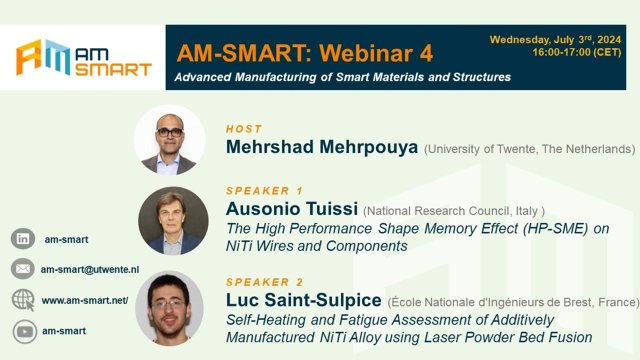
- Webinar 5, September 2024

Host: Thomas Niendorf (University of Kassel, Germany)
Speaker 1: Christian Leinenbach (Empa-Swiss Federal Laboratories for Materials Science and Technology, Switzerlands)
Title: Control of microstructure and shape memory properties of a Fe-Mn-Si-based shape memory alloy during laser powder bed fusion
This presentation will explore some recent advances in modifying the microstructure of FeMnSi-based shape memory alloys (SMAs) and thereby their shape memory properties through laser powder bed fusion (L-PBF). We demonstrate how varying the scan speed produces samples with coarse elongated grains with strong <001> orientation or with finer equiaxed grains. Furthermore, it is shown how significant microstructural variations are achieved by modifying L-PBF scanning strategies. Selective Mn evaporation is exploited to tailor phase compositions, resulting in graded-microstructure samples with distinct bcc-δ and fcc-γ phases. These approaches enhance the shape memory effect and strength of FeMnSi-based SMAs, offering valuable insights for advancing additive manufacturing technologies for high performance SMA applications.
1. I. Ferretto, A. Borzi, D. Kim, N.M. Della Ventura, E. Hosseini, W.J. Lee, C. Leinenbach, Control of microstructure and shape memory properties of a Fe-Mn-Si-based shape memory alloy during laser powder bed fusion, Additive Manufacturing Letters 3 (2022) 100091
2. I. Ferretto, A. Sharma, D. Kim, N.M. Della Ventura, X. Maeder, J. Michler, E. Hosseini, W.J. Lee, C. Leinenbach, Fabrication of FeMnSi-based shape memory alloy components with graded-microstructures by laser powder bed fusion, Additive Manufacturing 78 (2023) 103835
Speaker 2: Philipp Krooß (University of Kassel, Institute of Materials Engineering - Metallic Materials, Germany)
Title: Electron Beam Powder Bed Fusion of Binary Ni-Ti Shape Memory Alloys – On The Impact of TiC on Functional Properties)
Shape memory alloys (SMA), such as Ni-Ti, gained a lot of attention as promising materials for actuation and damping applications. Whereas thermomechanical processing widened potential applications of these alloys in the last decades, additive manufacturing (AM) processes are still limited. However, the possibility to process near-net shaped functional materials still motivates recent research in the field of AM. Especially the characterization of microstructural and functional properties in correlation with process parameters are in focus. The present study focuses on the impact of an increased carbon content in a Ni-Ti SMA processed via electron beam powder bed fusion. The functional properties of the processed material are discussed in view of chemical and microstructural findings. The results reveal a high reversibility as well as excellent cyclic stability of the superelastic material properties.
1. P. Krooß, C. Lauhoff, T. Gustmann, T. Gemming, C. Sobrero, F. Ewald, F. Brenne, T. Arold, M. Nematolahi, M. Elahinia, J. Thielsch, J. Hufenbach, T. Niendorf, “Additive Manufacturing of Binary Ni–Ti Shape Memory Alloys Using Electron Beam Powder Bed Fusion: Functional Reversibility Through Minor Alloy Modification and Carbide Formation,” Shap. Mem. Superelasticity 8, 2022, 452-462. DOI: https://doi.org/10.1007/s40830-022-00400-2

- Webinar 6, December 2024
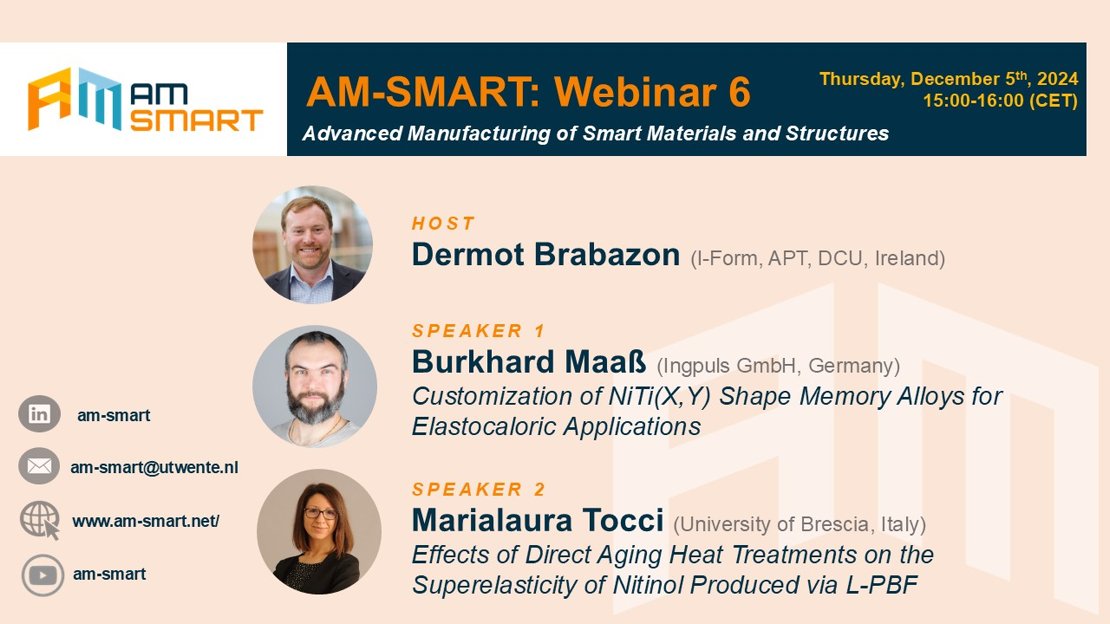
Host: Dermot Brabazon (I-Form, APT, DCU, Ireland)
Speaker 1: Burkhard Maaß (Ingpuls GmbH, Germany)
Title: Customization of NiTi(X,Y) Shape Memory Alloys for Elastocaloric Applications
NiTi-Shape Memory Alloys are mostly used for applications in medical devices or actuator systems. The emerging field of elastocalorics combines many of the requirements of both existing technologies. With the potential of both helping to make cooling and heating more sustainable and at the same time multiplying the world’s market of Shape Memory alloy production, it is a very interesting field to be active in as an SMA producer. The existing alloys are not really the best fit for Elastocalorics, and therefore, there is a need for customized Shape Memory Alloys. Hysteresis, the material’s COP (Coefficient of performance), and cyclic stability are among the most important requirements. For cascaded systems, also precisely controlled alloy variations with close sequences of changing Af-temperatures. In this work, we present our recent results on the processing, training, and characterization of binary and quaternary alloys, wire, and sheet/ribbon for elastocaloric applications.
Speaker 2: Marialaura Tocci (University of Brescia, Italy)
Title: Effects of Direct Aging Heat Treatments on the Superelasticity of Nitinol Produced via L-PBF
Nitinol (NiTi) alloy is widely recognized as a popular shape memory material, used in various biomedical and engineering applications. Recent research has focused on producing NiTi biomedical devices using laser powder bed fusion (L-PBF). Achieving superelasticity is essential for most NiTi components, especially for endovascular surgeries (e.g., stents), and is typically obtained through heat treatments. Given the differences between conventional and additive manufacturing (AM) methods, many studies aim to optimize heat treatments for AM parts. However, few studies explore direct aging, where aging is performed without prior solution annealing. This presentation covers recent findings on the effects of short-time direct aging heat treatments on the mechanical properties and microstructure of AM NiTi alloy. The results revealed high cyclic stability and superelastic recovery up to 10% deformation in direct-aged alloys, suggesting that solution treatment may not be necessary to achieve superelasticity, demonstrating the effectiveness of direct aging.
1. Abrami M.B., Tocci M., Brabazon D., Cabibbo M., Pola A., “Effects of Direct Aging Heat Treatments on the Superelasticity of Nitinol Produced via Laser Powder Bed Fusion”. Metall Mater Trans A 55, 3889–3908 (2024). https://doi-org.proxy.unibs.it/10.1007/s11661-024-07513-6

2025
- Webinar 7, February 2025

Host: Efrain Carreño-Morelli (HES-SO Valais-Wallis, Switzerland)
Speaker 1: Jose M. San Juan (University of the Basque Country, Spain)
Title: Microstructure and Functional Properties of Cu-Al-Ni Shape Memory Alloys Processed by LPBF Technique
Additive manufacturing (AM) offers new processing capabilities for shape memory alloys (SMA) and is already being applied to NiTi-based SMAs. Recently, Cu-based SMAs are also attracting the attention because of some advantages over NiTi SMAs for high-temperature applications. However, AM of Cu-based SMAs constitutes a challenge due to the inherent processing difficulties associated with its high thermal conductivity and the microstructure required to obtain good functional properties. In this presentation, I will overview some recent works in which powders of Cu-Al-Ni SMA were processed by laser powder bed fusion (LPBF). The processing parameters were optimized and the microstructure and the mechanical and functional properties of shape memory and superelasticity are comparatively analyzed. An outstanding 2.7 % fully recoverable superelastic strain, and ±4% shape memory recovery was obtained by LPBF. These results are compared with the ones obtained in samples, produced with the same powders, by the classical powder metallurgy route.
1. M. Pérez-Cerrato, I. Fraile, J.F. Gómez-Cortés, E. Urionabarrenetxea, I. Ruiz-Larrea, I. González, M.L. Nó, N. Burgos, J.M. San Juan. Designing for Shape Memory in Additive Manufacturing of Cu-Al-Ni Shape Memory Alloy Processed by Laser Powder Bed Fusion. Materials 15 (2022) 6284.
2. M. Pérez-Cerrato, J.F. Gómez-Cortés, E. Urionabarrenetxea, I. Ruiz-Larrea, I. Ayesta, M.L. Nó, N. Burgos, J.M. San Juan. Optimizing the laser powder bed fusion processing parameters of Cu-Al-Ni shape memory alloys: Microstructure and functional properties relationship. Virtual & Physical Prototyping (2025) Accepted, in press.
Speaker 2: Muzi Li (IMDEA Materials Institute, Madrid, Spain)
Title: The microstructure and mechanical properties of nitinol manufactured by LPBF: differences between Ni-rich and Ti-rich compositions
The utilization of laser powder bed fusion (LPBF) for nitinol alloys has garnered significant interest, owing to its capability to achieve a 4D response through the shape memory (SME) and superelastic (SE) effects. In this work, Ti-rich and Ni-rich nitinol parts have been additively manufactured by LPBF on Ti substrates to study their microstructure and mechanical response and their corresponding shape memory and superelastic effects. Various processing parameters were studied, including the use of post-printing heat treatments. Significant differences in printability were found between Ti-rich and Ni-rich nitinol. Generally speaking, Ti-rich nitinol showed a better printability and the manufactured parts offered a significant SME, independent of processing parameters and thermo-mechanical history. On the contrary, the printability of Ni-rich nitinol was seriously compromised by severe warping effects, and although the SE could be found for all conditions, the extent of SE was very dependent on thermo-mechanical history.
1. Díaz Lantada, A., Vega, C., Zapata Martínez, R., Rendón, M., Li, M., Contreras-Almengor, Ó., Ordoño, J., Solórzano-Requejo, W., Vasic, M., Manuel Munoz-Guijosa, J. and Molina-Aldareguia, J. (2024). Additive Manufacturing of Nitinol for Smart Personalized Medical Devices: Current Capabilities and Challenges. In Proceedings of the 17th International Joint Conference on Biomedical Engineering Systems and Technologies - BIODEVICES.

- Webinar 8, April 2025
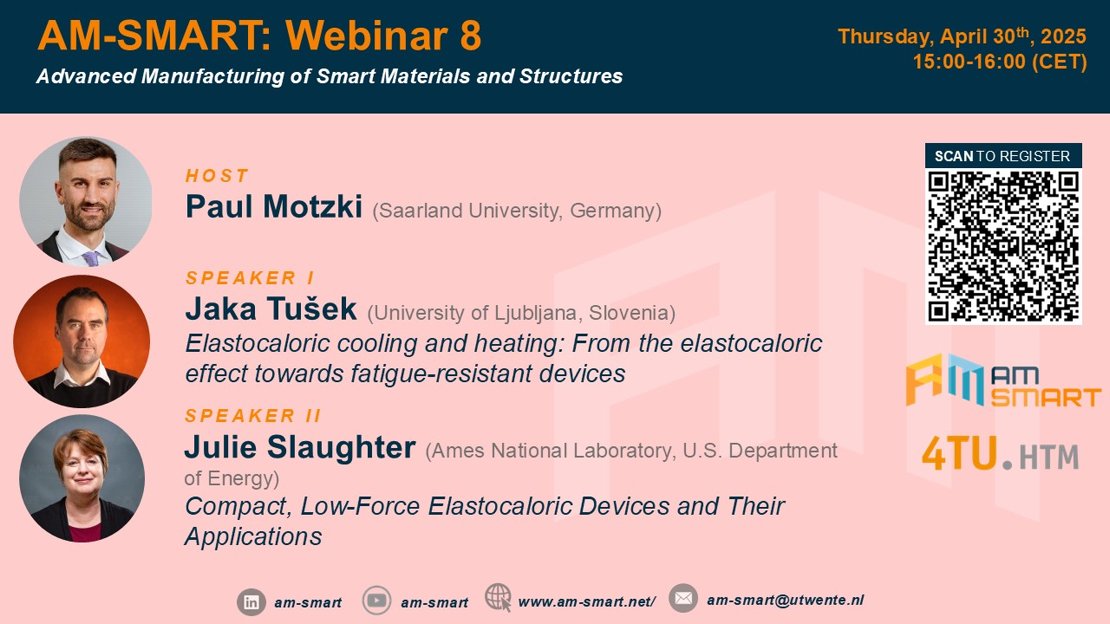
Host: Paul Motzki (Saarland University, Germany)
Speaker I: Jaka Tušek (University of Ljubljana, Slovenia)
Title: Elastocaloric cooling and heating: From the elastocaloric effect towards fatigue-resistant devices
Elastocaloric cooling/heating is emerging as a promising alternative to nowadays widely used, but environmentally harmful vapor compression technology. It is based on the elastocaloric effect that occurs in superelastic shape memory materials, such as Ni-Ti based alloys.
In the first part of the talk, I will present the basics of the elastocaloric effect and different concepts of the elastocaloric devices developed to date. In the second part of the talk, I will focus on the development of fatigue-resistant elastocaloric regenerative device based on Ni-Ti tube loaded in compression and a loading mechanism that allows for work recovery. In the final part of the talk, I will discuss future improvements, such as more efficient elastocaloric materials and better regenerator structures, required for further bosting the efficiency of elastocaloric devices.
1. J. Tušek, K. Engelbrecht, D. Eriksen, S. Dall’Olio, J. Tušek, N. Pryds, A regenerative elastocaloric heat pump, Nature Energy 1 (2016) 16134
2. Ž. Ahčin, S. Dall’Olio, A. Žerovnik, U. Žvar Baškovič, L. Porenta, P. Kabirifar, J. Cerar, S. Zupan, M. Brojan, J. Klemenc, J. Tušek, High-performance cooling and heat pumping based on fatigue-resistant elastocaloric effect in compression, Joule 6 (2022) 2338-2357
Speaker II: Julie Slaughter (Ames National Laboratory, U.S. Department of Energy)
Title: Compact, Low-Force Elastocaloric Devices and Their Applications
Advanced laboratory-scale devices using commercially-available nickel-titanium alloys (Nitinol) as refrigerants show great promise to meet the performance, efficiency, and scalability needed for applications such as refrigeration, air conditioning, and heat pumping. Because it is based on a solid-state phase transformation it does not rely on harmful refrigerants, high pressure fluid lines, and noisy compressors used in today’s technology.
While there are many materials that exhibit the elastocaloric effect, I will focus on the properties of superelastic nickel-titanium alloys (Nitinol) and how it can be used in active elastocaloric regenerators. Next, I will discuss a low-force active regenerator based on a composite structure tailored for air conditioning. My discussion will center around recent results and how this concept can be scaled to a larger device, including work recovery. I will also discuss a second elastocaloric device concept that is based on bending Nitinol wires or strips. This device is aimed at personal cooling and can be scaled up for full-sized air conditioning. Finally, I will discuss future applications and the materials and devices needed to support this emerging technology.
This work was supported by the U.S. Department of Energy (DOE) and the U.S. Department of Defense. The research was performed at Ames National Laboratory, which is operated for the U.S. DOE by Iowa State University under contract # DE-AC02-07CH11358.
1. Czernuszewicz, A., Griffith, L., Slaughter, J., & Pecharsky, V. (2020). Low-force compressive and tensile actuation for elastocaloric heat pumps. Applied Materials Today, 19, 100557. https://doi.org/10.1016/j.apmt.2020.100557
2. Slaughter, J., Czernuszewicz, A., Griffith, L., & Pecharsky, V. (2020). Compact and efficient elastocaloric heat pumps — Is there a path forward? Journal of Applied Physics, 127(19), 194501. https://doi.org/10.1063/5.0003275
The videos of all webinars are available on our YouTube channel.

